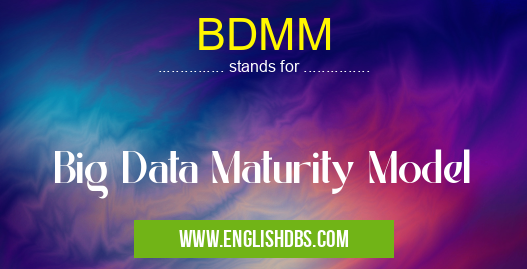What does BDMM mean in UNCLASSIFIED
BDMM stands for Big Data Maturity Model. It is a framework that helps organizations assess their current level of maturity in managing and utilizing big data. The model provides a structured approach for organizations to identify areas for improvement and develop a roadmap for achieving their big data goals.

BDMM meaning in Unclassified in Miscellaneous
BDMM mostly used in an acronym Unclassified in Category Miscellaneous that means Big Data Maturity Model
Shorthand: BDMM,
Full Form: Big Data Maturity Model
For more information of "Big Data Maturity Model", see the section below.
Components of BDMM
The BDMM consists of five key components:
- Data Strategy: This component assesses an organization's overall approach to big data management. It includes the definition of data-driven objectives, the establishment of a data governance framework, and the development of a data architecture.
- Data Management: This component focuses on the technical aspects of big data management, including data acquisition, storage, processing, and analysis. It evaluates the organization's capabilities in handling diverse data types, ensuring data quality, and implementing appropriate data security measures.
- Data Analytics: This component assesses an organization's ability to extract insights from big data. It includes the use of statistical techniques, machine learning algorithms, and data visualization tools to identify patterns, trends, and anomalies in data.
- Data Culture: This component measures the extent to which an organization's culture embraces big data. It includes the evaluation of employee understanding of big data, the level of data literacy within the organization, and the availability of resources for big data education and training.
- Data Value: This component assesses the impact of big data on an organization's decision-making and business outcomes. It includes the measurement of return on investment (ROI) from big data initiatives and the identification of areas where big data has improved operational efficiency or created new revenue streams.
Benefits of BDMM
Using the BDMM can provide several benefits for organizations, including:
- Improved data management: The model helps organizations identify weaknesses in their data management practices and develop strategies to improve data quality, security, and governance.
- Enhanced data analytics: By assessing an organization's data analytics capabilities, the model enables organizations to identify opportunities for improving data analysis processes and extracting more valuable insights from data.
- Increased data value: The model helps organizations identify ways to leverage big data to improve decision-making, drive innovation, and create competitive advantages.
- Better data culture: The BDMM promotes a culture of data-driven decision-making and encourages employee understanding and adoption of big data technologies.
Conclusion
The BDMM is a valuable tool for organizations that want to improve their big data management and utilization practices. By providing a structured framework for assessment and improvement, the model enables organizations to identify areas for growth, develop a roadmap for success, and ultimately maximize the value of their big data initiatives.
Essential Questions and Answers on Big Data Maturity Model in "MISCELLANEOUS»UNFILED"
What is the Big Data Maturity Model (BDMM)?
The Big Data Maturity Model (BDMM) is a framework that helps organizations assess their maturity level in managing and leveraging big data. It provides a structured approach to evaluate an organization's capabilities in various aspects of big data, including data governance, data management, analytics, and data science.
What are the benefits of using the BDMM?
The BDMM offers several benefits to organizations, such as:
- Identifying strengths and weaknesses in big data management
- Establishing a roadmap for improvement
- Enhancing data-driven decision-making
- Improving data security and compliance
- Gaining a competitive advantage through effective big data utilization
How does the BDMM work?
The BDMM consists of five maturity levels:
- Level 1: Basic
- Level 2: Managed
- Level 3: Defined
- Level 4: Predictable
- Level 5: Optimized
Organizations assess their current state against these levels and develop a plan to progress towards higher maturity levels. The BDMM provides guidance on best practices, tools, and technologies to support this journey.
Who can benefit from using the BDMM?
The BDMM is suitable for organizations of all sizes and industries that want to improve their big data capabilities. It is particularly valuable for organizations that process and analyze large volumes of data to drive business outcomes.
How can I implement the BDMM in my organization?
To implement the BDMM, follow these steps:
- Assess your current maturity level
- Identify areas for improvement
- Develop a roadmap for reaching higher maturity levels
- Monitor your progress and make adjustments as needed
BDMM also stands for: |
|
| All stands for BDMM |
